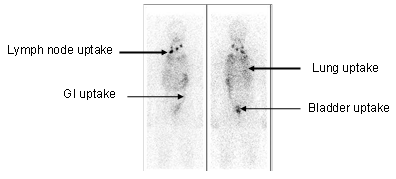And to you, Mr. President.
Feliz año nuevo!
It certainly has been a while since my last update (about three months), so I figured it was time for a new post. I think I let things slip because there haven't been a lot of thyroid-related events in my life as of late, which is probably a good thing. But, new developments have occurred, so...might as well catch up!
I had a wonderful, relaxing break. Thanksgiving was great, spent it with my own extended family and Emily's. My sister was in town with her husband and my niece too, which was nice.
The office was closed the week between Christmas and New Year's Day, so it was ample opportunity to kick back and relax. Vacation is never long enough though.
However, the Monday before Christmas I was due back at my endocrinologist's office for my 6-month blood test and checkup. I was hoping for some good Christmas news!
The first blood test result came back the next day, for my TSH level. If you recall from my Lesson in Blood post, this is the measure of if my thyroid hormone dosage is adequate. This time, it was at an all-time high of 4.3. Not a big deal, but it meant my doctor had to prescribe a new dosage of levothyroxine, going up from 125mcg to 137mcg. My pill went from brown to blue. Luckily, my inadequate level of thyroid hormones was simply in the bloodwork; I had not been feeling any symptoms of hypothyroidism up to that point.
Que delicioso!
The next result came in the next week, no doubt delayed due to the holidays. This was the super important one: my Thyroglobulin (Th) level. Th is the protein produced by thyroid tissue, whether cancerous or not; any rise in this likely means the existence of cancer, since non-cancerous thyroid tissue doesn't grow back.
Luckily, this number was at an all-time low of <0.2. While the goal of this number is to be undetectable, my doctor was happy with this result. From what I've read, it can take as much as a whole year after RAI to reach the final Th level, since the dying thyroid tissue caused by the RAI causes a spike in the release of Th.
It is important to note that Th levels are useful numbers, but are more useful when looked at over time. That way, you can track changes (specifically increases) in the Th level.
Here is my timeline so far:
3.5 weeks post-surgery: 1.3 (unstimulated)
Day of RAI: 8.8 (stimulated by Thyrogen)
3 days post RAI: 12.9 (stimulated by leftover effects of Thyrogen, and release of Th by dying thyroid cells)
6 months post-surgery: <0.2 (unstimulated)
All in all, a good looking path so far. My doctor also ordered a routine ultrasound, to see what my thyroid bed looked like post-surgery, so I had it done on January 15th.
A couple days later, I got the results via e-mail with my endocrinologist. While not the perfect result I was hoping for, there seems to be no cause for alarm.
According to her discussion with the radiologist who examined my ultrasound imaging, the film showed "residual tissue, probably thyroid." Most likely it was just left over from the surgery, which is common, and the radioactive iodine did not fully kill it yet. They agreed the best course of action was to continue monitoring my blood Th levels (which look great so far) and to ultrasound again in 6 months. At that time, they will try to confirm that the tissue is either stable in size, or better yet, shrinking and showing signs of further atrophy from the RAI.
I know that all thyroidectomies never result in 100% removal of all thyroid tissue, so while this isn't a big shocker, I guess I was hoping that I was in the camp where no residual thyroid tissue would remain at this point after the RAI treatment. I have read in various articles that it could take up to a year after RAI for it do to its full work on killing all residual thyroid tissue, so I don't think I'm out of the norm for people 6 months post-treatment for thyroid cancer.
In any case, the better news is that the radiologist did not feel the residual tissue appeared cancerous, and there were no signs of lymph node metastasis, so all in all, I'm happy with the results and looking forward to continuing with life! Emily and I are trying to plan trips in 2016, since we haven't been able to take our official "post-cancer" celebratory trip, so...stuff to look forward to!
Yes it does, meme frog.
















































